
|
Sale 114
The New York Sale
| Lot |
Photo |
Description |
Bidding |
Lot 350 |
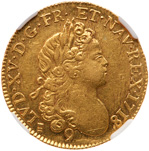 |
Louis XV (1715-1774). Gold Louis d'or a la croix de Malte, 1718-9 (Rennes). Young laureate bust of king right. Rev. Maltese cross (Fr 453; Gadoury 336; KM 438.22). In NGC holder graded AU 53, light obverse striation marks with considerable mint brilliance. Value $1,800 - UP
The reverse type of the louis d'or a la croix du Saint-Esprit ("gold Louis with the cross of the Holy Spirit") is often described as depicting a Maltese cross and representing the chivalric Order of Malta, but it is in fact the similar cross used by the French Ordre du Saint-Esprit ("Order of the Holy Spirit"). This order was created by Henri III on December 31, 1578, as a means of binding the powerful nobles of France more closely to the king. It was successful in this regard and was therefore abolished during the French Revolution (1789-1799). However, it was recognized by the restored Louis XVIII. A painted portrait of Louis XV by Carle Van Loo depicts the king wearing the cross and other insignia of the Ordre du Saint-Esprit.
View details and enlarged photos
|
|
Lot 351 |
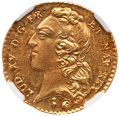 |
Louis XV (1715-1774). Gold Half Louis d'or au bandeau, 1743-W (Lille). Large head of king left with hair ribbon. Rev. Crown over two oval shields of France and Navarre (Fr 465; Gadoury 330; KM 517.9). In NGC holder graded MS 63, a sharply struck choice mint state example with sparkling mint brilliance. Value $2,500 - UP
In 1740 the traditional obverse portrait bust of Louis XV used for the louis d'or aux lunettes ("gold Louis with glasses") was replaced by a new portrait head depicting the king wearing his hair bound by a simple diadem. This new portrait type caused the louis d'or struck between 1740 and 1771 to be described as au bandeau ("with a diadem"). The introduction of this type took place at the same time that Louis XV was revaluing the louis d'or from 20 livres to 24 livres and entering upon on a series of expensive wars beginning with the War of the Austrian Succession (1740-1748). It is unclear whether the diademed portrait was intended to recall images of Alexander the Great. Regardless, Louis XV was no world conqueror. Most of his wars ended in defeat and his reign saw the loss of much French territory, particularly in the New World.
View details and enlarged photos
|
|
Lot 352 |
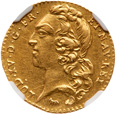 |
Louis XV (1715-1774). Gold Half Louis d'or au bandeau, 1743-A (Paris). Large head of king left with hair ribbon. Rev. Crown over two oval shields of France and Navarre (Fr 465; Gadoury 330; KM 517.1). In NGC holder graded AU 53, traces of luster. Value $1,000 - UP
View details and enlarged photos
|
|
Lot 353 |
 |
Louis XV (1715-1774). Gold Louis d'or au bandeau, 1745-W (Lille). Large head with hair ribbon. Rev. Crown over two oval shields (Fr 464; Gad 341; KM 513.22). In NGC holder graded MS 63, flashy mint brilliance with great eye appeal. Value $1,750 - UP
View details and enlarged photos
|
|
Lot 354 |
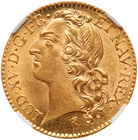 |
Louis XV (1715-1774). Gold Louis d'or au bandeau, 1748-W (Lille). Large head of king left with hair ribbon. Rev. Crown over two oval shields of France and Navarre (Fr 464; Gadoury 341; KM 513.22). In NGC holder graded MS 64, a sharply struck choice mint state example with full original mint brilliance. Value $2,000 - UP
Ex Terner Collection by Private Treaty.
View details and enlarged photos
|
|
Lot 355 |
 |
Louis XV (1715-1774). Gold 2 Louis d'or au bandeau, 1758-BB (Strasbourg). Large head with hair ribbon. Rev. Crown over two oval shields (Fr 463; Gad 346; KM 519.4). In NGC holder graded MS 61, nearly full original mint luster. Value $1,750 - UP
View details and enlarged photos
|
|
Lot 356 |
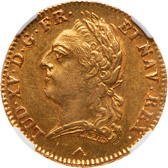 |
Louis XV (1715-1774). Gold 2 Louis d'or a la vieille tete, 1772-W (Lille). Older laureate head of king left. Rev. Crown over two oval shields of France and Navarre (Fr-466; Gadoury 347; KM 557.8). In NGC holder graded AU 58, a pleasing well struck example with considerable original mint luster. Rare. Value $7,500 - UP
The last portrait type introduced for the coinage of the long-reigning Louis XV was the so-called vielle tete ("old head") type, which replaced the portrait au bandeau in 1771. The new type has a Classical air to it, depicting Louis XV wearing a laurel wreath in order to cast him as a sort of latter-day Gallo-Roman Emperor. This Classical iconography was popular for European royal portraits of the eighteenth century, and was perhaps partly intended to reflect the learning deemed to be desirous in a monarch ruling in the Age of Enlightenment.
View details and enlarged photos
|
|
Lot 357 |
 |
Louis XVI (1774-1792). Gold Louis d'or au buste habille, 1775-W (Lille). Uniformed bust left. Rev. Crown over two oval shields of France and Navarre (Fr 471; Gadoury 359; KM 567.15). In NGC holder graded AU 55, traces of luster remaining. Value $1,750 - UP
The louis d'or au buste habillé ("gold Louis with dressed bust") was introduced at the outsed of the reign of Louis XVI in 1774 and gains its popular name from the obverse depiction of the king. He is shown wearing the full uniform of the Ordre du Saint-Esprit ("Order of the Holy Spirit"). Both the sash and the cross breast-plaque of the order are visible on the portrait bust.
View details and enlarged photos
|
|
Lot 358 |
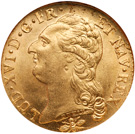 |
Louis XVI (1774-1792). Gold Louis d'or au buste nu, 1786-D (Lyon). Bare older bust of king left. Rev. Crown over two square shields of France and Navarre (Fr 475; Gadoury 361; KM 591.5). In NGC holder graded MS 65, superb quality with great eye appeal. Value $1,750 - UP
In 1774 a much plainer bust type was introduced for the louis d'or known as au buste nu ("with naked bust") referring to the fact that the portrait is unadorned with clothing as was the previous au buste habillé variety. The present coin was struck in 1786, the year that the Eden Treaty was signed between France and Great Britain in a misguided attempt by the French government to shore up the tottering economy. The treaty ultimately favored English interests. All Frenchmen and not just the king's portrait teetered on the brink of losing their shirts.
View details and enlarged photos
|
|
Lot 359 |
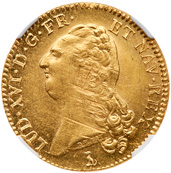 |
Louis XVI (1774-1792). Gold 2 Louis d'or, 1786-T (Nantes). Bare head of king left. Rev. Crown over two square shields (Fr 474; KM 592.14; Gad 363). In NGC holder graded MS 63+, a few adjustment marks, full original mint brilliance. Value $1,500 - UP
View details and enlarged photos
|
|
Lot 360 |
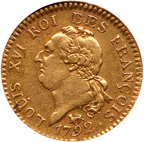 |
Louis XVI (1774-1792). Gold Constitutionnel Louis d'or of 24 Livres, 1792-A (Paris). Bare head of king left. Rev. Guardian angel Genius inscribing the Constitution on a tablet (Fr 477; Gadoury 61; KM 617.1). In NGC holder graded XF 40. Scarce type. Value $4,000 - UP
On August 26, 1789, the French National Assembly issued the Declarations of the Rights of Man as the generalized precursor to a constitution that would bring an end to the excesses of the Ancien Regime. Not long after, on October 5, Louis XVI and his family were forcibly removed from Versailles and brought to the Tuileries Palace in Paris where it was thought that they would be more accountable to the people. After several drafts and much negotiation, on June 3, 1791, Louis XVI accepted a constitution that reorganized the state and abolished absolute rule, but preserved some of the king's powers, such as the nomination of ambassadors, military commanders, and ministers. However, a few weeks after recognizing the constitution, Louis XVI packed up his family and attempted to flee to Varennes in the dead of night. He was caught and brought back to Paris where he was seen as the betrayer of the moderate revolutionary element that would have preferred constitutional monarchy to radical republicanism. No longer willing to accept Louis XVI as a partner in governing France, the National Assembly tore up the Constitution of 1791 and abolished the monarchy on September 21, 1792. In the following year Louis XVI was found guilty of treason and executed by guillotine.
While the Constitution of 1791 remained in force, French coins were still struck in the name of Louis XVI featuring his buste nu ("naked bust") portrait type. However, traditional heraldic and personal royal reverse types were replaced by new ones more appropriate to the revolutionary age. On the louis d'or the reverse depicts the Genius of the Revolution inscribing a constitution (presumably the Constitution of 1791) and for this reason the coin is commonly known as the louis d'or constitutionnelle ("constitutional gold Louis"). The present louis d'or constitutionnelle is dated 1792 and was therefore struck after general French disillusionment with the king, but before the abolition of the monarchy.
View details and enlarged photos
|
|
Lot 361 |
 |
National Convention (1792-1795). Gold Louis d'or of 24 Livres, 1793-W (Lille). First Republic, Convention, 1792-1795. Winged genius (angel) right, inscribing "Constitution" on tablet supported on altar, fasces and Liberty Cap at left, rooster at right; REGNE DE LA LOI. Rev. Value and mintmark within oak wreath; around, REPUBLIQUE FRANÇOISE, L'AN II. Year 2 of the Revolution, during the so-called reign of the law (Fr 478; Gadoury 62; KM 626.5). In NGC holder graded MS 61, lovely original mint brilliance of this scarce one year type. Value $7,000 - UP
On February 5, 1793, ten days after the execution of Louis XVI, the National Assembly abolished the use of the royal portrait. This made necessary the redesigning of the coinage since the head of Louis XVI had continued to be struck on French coins from the establishment of the Constitution of 1791 until January 26, 1793-five days after the death of Louis XVI. Thereafter, the louis d'or ceased to be struck under this name and was replaced by a new gold 24-livres piece (the value of the louis d'or in terms of silver). On the new coins the obverse portrait of Louis XVI was replaced by the image of the Genius inscribing the constitution (now intended to represent the republican Constitution of 1793) that had previously appeared on the reverse of the louis d'or constitutionnelle ("constitutional gold Louis"). Surrounding this type, where the legend naming the king had previously appeared is now an inscription extolling the new sovereign in France: Law. Alas, this new ruler was destined to be deposed in fairly short order. In June 1793 the rule of Law was destined to be distorted into the Reign of Terror.
View details and enlarged photos
|
|
Lot 362 |
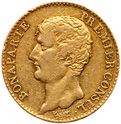 |
Napoelon Bonaparte, Consulate (1799-1804). Gold 20 Francs, AN XI-A (1802-1804) Paris mint. Bare head left with title of First Consul. Rev. Value within wreath (Fr 480; Gad 1020; KM 651). In PCGS holder graded AU 53. Value $500 - UP
On November 10, 1799, the general Napoleon Bonaparte and his brother Lucien perpetrated the bloodless coup d'état known as the Coup of 18 Brumiere (the date of the coup according to the French Revolutionary calendar). Together they forced the Directors of the Revolutionary government to resign and abolished the Constitution of Year III (1795) that had established the French Directorate. In their place a new constitution, the Constitution of Year VIII, was adopted on December 4, 1799, calling for a republican government led by consuls with 10-year terms. While there were three men in office, all of the real power of government devolved upon Napoleon who served as First Consul. The unpretentious bare-headed depiction of Napoleon on this 20-franc gold piece was perhaps intended to present the First Consul in the image of an ancient Roman Republican, but image seems to be modeled on the bare-headed depictions of Octavian (the future Augustus) struck shortly after he had crushed his opponents at the Battle of Actium (31 BC), but before he had taken the title of Augustus (27 BC) and become the first Roman Emperor. As First Consul Napoleon occupied a similar position to that of Octavian/Augustus in the aftermath of Actium. It was only a matter of time before he too would be Emperor.
View details and enlarged photos
|
|
Lot 363 |
 |
Napoleon Bonaparte, First Empire (1804-1814). Gold 20 Francs, AN 12-A (1803/4) Paris mint. Bare head left, Napoleon as Empereur. Rev. Value within wreath, date below (Fr 487; KM 661; Gad 1021). In NGC holder graded MS 63, with pleasing original mint fresh luster. Rare type. Value $1,250 - UP
View details and enlarged photos
|
|
Lot 364 |
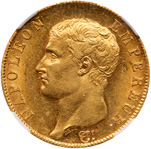 |
Napoleon Bonaparte, First Empire (1804-1814). Gold 40 Francs, AN 13-A (1804) Paris mint. Bare head left, Napoleon as Empereur. Rev. Value within wreath, date below (Fr 481; KM 664.1; Gad 1081). In NGC holder graded MS 61, with pleasing original mint fresh luster. Rare in grade. Value $1,500 - UP
The present gold franc multiples name Napoleon as Emperor but reflect a lack of confidence in the idea of completely abandoning the republican style of the preceding revolutionary regime and the period of the Consulate. Indeed, the present coins were struck at the end of the last year of the Consulate (lot 314207) and in the first full year after its dissolution (lot 31206). The bare-headed obverse portrait is intended to mimic Roman numismatic portraits of Augustus, the first Roman Emperor, who had also been careful to couch the transition to empire in republican terms. It is also a carry-over from the coins of Napoleon as First Consul, as if to imply no real change except in title to belie the fact that he was in fact a new monarch. In the same vein, the year is expressed not in the years of the Christian Era, but in years of the French Revolutionary Era which, ironically enough, counted from September 22, 1792, the date of the abolition of the French monarchy. It is also notable that while Napoleon is named as Emperor on the obverse the reverse still refers to France as a republic.
View details and enlarged photos
|
|
Lot 365 |
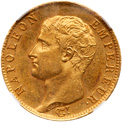 |
Napoleon Bonaparte, First Empire (1804-1814). Gold 20 Francs, 1806-A (Paris). Bare head left, Napoleon as Empereur. Rev. Value within wreath, date below (Fr 487a; KM 674.1; Gad 1023). In NGC holder graded AU 58. Value $500 - UP
This gold 20-franc piece of 1806 has advanced the Napoleonic imperial image a little further away from French Revolutionary ideals in its abandonment of the Revolutionary Era date below the wreath on the reverse. Now the date is expressed according to the Christian Era used by every other contemporary European state. However, the bare-headed portrait and the reverse legend naming the French Republic show that in 1806, not long after his crushing victory over Tsar Alexander I of Russia and the Holy Roman Emperor Francis II at Austerlitz (December 2, 1805), Napoleon was still very cautious about dropping all references to the French Revolutionary past.
View details and enlarged photos
|
|
Lot 366 |
 |
Napoleon I (1804-1814). Gold 20 Francs, 1808-A (Paris). Laureate head left. Rev. Value within wreath, date below (Fr 499; KM 687.1; Gad 1024). In PCGS holder graded MS 63. Value $1,000 - UP
The gold 20-franc issues of 1807 and 1808 are transitional in that they retain the reverse type naming the French Republic that had been used since the time of the Consulate, but employ a new portrait type that leaves no ambiguity about Napoleon's imperial ambitions. Now the bare-headed bust is gone and replaced by a new image of Napoleon shown wearing the laurel wreath-the usual headgear for an emperor. This new portrait was a bold statement because it placed his image in the company of absolute monarchs-anathema to French Revolutionary ideals. Louis XIV and Louis XV had both appeared on their coins wearing a laurel wreath, although the hated Louis XVI had never adopted this portrait style for his coins. Not only does the present coin symbolize Napoleon's betrayal of the French Revolution but it was also struck in the year that the Emperor turned against his former ally Ferdinand VII of Spain and committed his army to the quagmire of the Peninsular War (1807-1814).
View details and enlarged photos
|
|
Lot 367 |
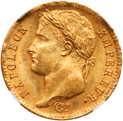 |
Napoleon I (1804-1814). Gold 20 Francs, 1811-A (Paris). Laureate head left. Rev. Value within wreath, date below (Fr 511; KM 695.1; Gad 1025). In NGC holder graded MS 65. Choice with a hint of toning. Rare in top grades. Value $1,250 - UP
Ex Terner Collection by Private Treaty.
View details and enlarged photos
|
|
Lot 368 |
 |
Napoleon I (1804-1814). Gold 40 Francs, 1812-A (Paris). Laureate head left. Rev. Value within wreath, date below (Fr 505; KM 696.1; Gad 1084). In NGC holder graded MS 64. Lovely original mint bloom. Rare in top grades. Value $1,500 - UP
These gold 20- and 40-franc pieces represent the final stage in the development of Napoleon's imperial coinage. Not only do they feature the laureate portrait introduced in 1807, but they finally omit all mention of the French Republic on the reverse. All pretense is gone and the reverse legend openly names the French Empire. This transformation from republic to empire on the coinage only took place in 1809, the year in which Napoleon defeated an alliance of the Austrian Empire, Great Britain, and several German states in the War of the Fifth Coalition. However, the present issues were produced in a rather different historical context. In 1811 Napoleon began preparations for a full-scale invasion of Russia. The actual campaign took place in 1812 and ended in disaster when the Russians burned their crops and Moscow itself ahead of the advancing Grande Armée. Napoleon's army was destroyed as it attempted to retreat through the bitter Russian winter. This blow to French morale and the great loss of trained military manpower played an important role in Napoleon's defeat by the Sixth Coalition two years later.
View details and enlarged photos
|
|
Lot 369 |
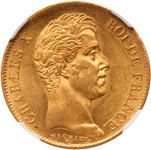 |
Charles X (1824-1830). Gold 40 Francs, 1830-A (Paris). Incuse letters on edge. Bare head right. Rev. Crowned arms within wreath, value at sides, date below (Fr 547; KM 721.1; Gad 1105). In NGC holder graded MS 63. Value $2,000 - UP
Charles-Philippe, the younger brother of the restored Louis XVIII, succeeded him as King Charles X on September 16, 1824. He was a poor fit for a France still trying to heal from the great upheavals of the French Revolution and the defeated Napoleonic Empire that followed. He had no taste for republicanism and little for constitutions, which immediately placed him at odds with many Frenchmen. He also lacked Napoleon's skills at propaganda and personality cult. Instead, he believed in the divine right of kings and opposed to civil liberties guaranteed by the Charter of 1814. His longing to return to the Ancien Regime became even clearer through his attempts to restore the influence of the Catholic Church and to reimburse former feudal landowners for their losses in the Revolution. The last straw came in 1830 when Charles X enacted the July Ordinances, which disbanded the Chamber of Deputies and censored the press. The French people responded by rioting in Paris and other major cities. This popular uprising, known as the July Revolution, forced Charles X to abdicate the throne and seek exile in England.
Ex R.L. Lissner Collection, CNG sale, August 1-2, 2014, lot 386.
View details and enlarged photos
|
|
Lot 370 |
 |
Second Republic (1848-1852). Gold 20 Francs, 1851-A (Paris). Head of Ceres right. Rev. Value within wreath, date below (Fr 566; KM 762; Gad 1059). In NGC holder graded MS 64. Value $500 - UP
The increasingly conservative character of the reign of Louis-Philippe (1830-1848) and deteriorating economic conditions in France led to public outcry against the king. Complaint was most commonly voiced at political banquets arranged to get around restrictive assembly laws. On February 22, 1848, Louis-Philippe at last outlawed the banquets, thereby provoking a general strike in Paris. This strike exploded into the Revolution of 1848 after soldiers guarding the French Ministry of Foreign Affairs accidentally killed 52 demonstrators. Louis-Philippe was forced to flee to England. A Second Republic was declared in France but its the viability was threatened almost immediately by the election of Charles Louis-Napoleon Bonaparte, the nephew of the deposed Emperor, to serve as its president. His policies often offended both radical republicans and conservatives in the National Assembly, but the popularity of his name gave him the support of the people. However, his real aim was to claim royal power. Although the Constitution of 1848 required him to step down at the end of his term, on December 2, 1851, Louis-Napoleon staged a self-coup and declared himself Prince-President with sweeping executive and legislative powers with a 10-year term. Within a year he declared a Second French Empire with himself as Emperor. Few seem to have mourned the passing of the Second Republic. When a plebiscite was held on the coup of 1851 7,439,216 voters are reported to have supported it with only 641,737 abstaining. 1.7 million voters abstained. The coinage of the Second Republic often features the head of Ceres, the Roman goddess of grain, on the obverse as a somewhat propagandistic emblem of prosperity. Poverty and hunger had fueled much of the popular support for the ouster of Louis-Philippe and the establishment of the republic. The type is modeled on ancient Greek depictions of Persephone on tetradrachms of Syracuse.
Ex Terner Collection by Private Treaty.
View details and enlarged photos
|
|
Lot 371 |
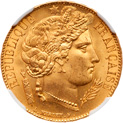 |
Second Republic (1848-1852). Gold 20 Francs, 1851-A (Paris). Head of Ceres right. Rev. Value within wreath, date below (Fr 566; KM 762; Gad 1059). In NGC holder graded MS 65. Value $500 - UP
View details and enlarged photos
|
|
Lot 372 |
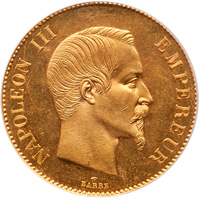 |
Napeoleon III (1852-1870). Gold 100 Francs, 1858-A (Paris). Bare head right. Rev. Crowned Imperial arms, value at sides, date below (Fr 569; KM 786.1; Gad 1135). In PCGS holder graded MS 63. Value $1,500 - UP
After the coup of 1851, Louis Napoleon initially contented himself with the new title of Prince President, but just less than a year later, on December 2, 1852, he arranged the proclamation of a Second French Empire with himself ruling as Emperor Napoleon III. His reign was beneficial to France in many ways. He oversaw the rebuilding of Paris, which had been damaged over the preceding decades by repeated revolutions and foreign occupation; He enacted forward-thinking social reforms aimed at improving the lot of the working class-including the right to strike; and oversaw increasing economic prosperity. Nevertheless, political opposition to his reign began to mount in the 1860s on the grounds that the reign of Napoleon III prevented the French people from enjoying the republic that so many had died to establish in the 1790s. Trouble was certainly in the offing, but Napoleon III ultimately did himself in when he allowed himself to be lured into the disastrous Franco-Prussian War. In this conflict not only was the Empire defeated by superior Prussian forces, but he surrendered and was taken captive following the infamous battle of Sedan on September 2, 1870. In the following year the National Assembly formally deposed Napoleon III and he went into exile in England.
View details and enlarged photos
|
|
Lot 373 |
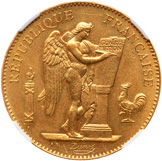 |
Third Republic (1871-1940). Gold 50 Francs, 1878-A (Paris). Genius writing on tablet. Rev. Value and date within wreath (Fr 591; KM 831; Gad 1113). In NGC holder graded AU 53. Value $1,200 - UP
In 1871 the Second French Empire collapsed under the weight of the defeat and capture of Napoleon III. In the face of this debacle the French National Assembly deposed the Emperor and in 1875 established a provisional government known as the Third Republic. Under the French Constitutional Laws of 1875, the new republic was to include an elected president, a Chamber of Deputies and a Senate. The early years of the Third republic were dominated by calls to restore the monarchy yet again, but republicanism won out. By the end of the 1880s it was fairly clear that the Third Republic would stand as a viable state in its own right rather than as a temporary measure waiting for a new revolution or the return of the Ancien Regime in one form or another. It was destined to survive intact until the German invasion of France and the creation of the puppet Vichy government in 1940. Ironically, while the political character of the Third Republic was generally moderate, the present 50-franc pieces look back to the much more extreme days of the French Revolution in their choice of obverse type.
View details and enlarged photos
|
|
Lot 374 |
 |
Third Republic (1871-1940). Gold 50 Francs, 1904-A (Paris). Genius writing on tablet. Rev. Value and date within wreath (Fr 591; KM 831; Gad 1113). In NGC holder graded MS 63. Value $1,250 - UP
View details and enlarged photos
|
|
|
|